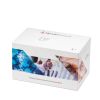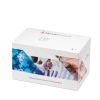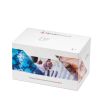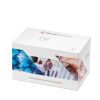sCD14, Human, ELISA kit – 1 x 96 det. - HK320-01
Quantity
1 x 96 det.
Catalog #
HK320-01
649,00 €
CD14, the 55-kDa glycoprotein known to function as a receptor for LPS, is expressed mainly on the surface of monocytes/macrophages, and PMN, the cells responsible for scavenging of LPS and bacteria.
Although monocytes and PMN are the main CD14 expressing cells few reports have described CD14 expression on B-cells, mesangial cells and basophils. The plasma protein LBP plays an important role in the LPS-CD14 mediated cell activation. In addition to the function as receptor for LPS, several other functions have been ascribed to CD14; next to the recognition of micro-organisms by the innate immune system CD14 also plays a role in cell-cell interactions.
Besides the membrane bound form of CD14, the soluble form of CD14 (sCD14), which lacks the GPI anchor, is also involved in LPS-induced cell activation. Two forms of sCD14 have been described. An approximately 48 kDa form, derived from monocytes membrane CD14, and a 56 kDa form, speculated to be directly released in plasma or supernatant after processing. sCD14 affects LPS functioning via several pathways. sCD14 is an intermediate in the transfer of LPS to lipoproteins, resulting into neutralization of LPS. On the contrary, sCD14 facilitates LPS activation of CD14-membrane negative cells like endo- and epithelium.
Furthermore, high concentrations of sCD14 were shown to block LPS-induced activation of monocytes. sCD14 thus both enhances and reduces cellular responses to LPS. sCD14 was demonstrated to be present in plasma in levels ranging from 2 - 4 µg/ml and to be enhanced in infectious diseases.
| Datasheet URL | https://www.hycultbiotech.com/wp-content/uploads/2022/06/HK320-0212.pdf |
|---|---|
| Quantity | 1 x 96 det. |
| Quantity | 1 x 96 det. |
| Standard range | 8.8-100 ng/ml |
| Detection level | 8.8 ng/ml |
| Working volume | 100 µl/well |
| Species | human |
| Application | The human sCD14 ELISA kit is to be used for the in vitro quantitative determination of human sCD14 in serum, plasma, urine, breast milk and cell culture supernatant samples. |
| Principle | The human sCD14 ELISA is a ready-to-use solid-phase enzyme-linked immunosorbent assay based on the sandwich principle with a working time of 3½ hours. The efficient format a 2 plate with twelve disposable 8-well strips allows free choice of batch size for the assay. Samples and standards are captured by a solid bound specific antibody. Biotinylated tracer antibody will bind to captured human sCD14. Streptavidin-peroxidase conjugate will bind to the biotinylated tracer antibody. Streptavidin-peroxidase conjugate will react with the substrate, tetramethylbenzidine (TMB). The enzyme reaction is stopped by the addition of oxalic acid. The absorbance at 450 nm is measured with a spectrophotometer. A standard curve is obtained by plotting the absorbance (linear) versus the corresponding concentrations of the human sCD14 standards (log). The human sCD14 concentration of samples, which are run concurrently with the standards, can be determined from the standard curve. |
| Storage and stability | Product should be stored at 4 °C. Under recommended storage conditions, product is stable for at least six months. |
| Precautions | For research use only. Not for use in or on humans or animals or for diagnostics. It is the responsibility of the user to comply with all local/state and Federal rules in the use of this product. Hycult Biotech is not responsible for any patent infringements that might result with the use of or derivation of this product. |
| References | 1. Dentener, M et al; Bacterial/permiability-increasing protein release in whole blood ex
vivo: strong induction by lipopolysaccharide and tumor necrosis factor-alpha. J Infect Dis
1996, 175: 108 2. Hiltermann, J et al; Ozone-induced inflammation assessed in sputum and bronchial lavage fluid from asthmatics: a new noninvasive tool in epidemiologic studies on air pollution and asthma. Free Radic Biol Med 1999, 27: 1448 3. Blais, D et al; Killing the messenger in the nick of time: persistence of breast milk sCD14 in the neonatal gastrointestinal tract. Pediatr Res 2006, 59: 371 4. Poikonen, K et al; Susceptibility of human monocyte-macrophages to Chlamydia pneumoniae infection in vitro is highly variable and associated with levels of soluble CD14 and C. pneumoniae IgA and human HSP-IgG antibodies in serum. Scand J Immunol 2008, 67: 279 |
| Disease | Gastroenterology, Infectious diseases |
| Application assays: | The human sCD14 ELISA kit is to be used for the in vitro quantitative determination of human sCD14 in serum, plasma, urine, breast milk and cell culture supernatant samples. |
|---|---|
| Principle: | The human sCD14 ELISA is a ready-to-use solid-phase enzyme-linked immunosorbent assay based on the sandwich principle with a working time of 3½ hours. The efficient format a 2 plate with twelve disposable 8-well strips allows free choice of batch size for the assay. Samples and standards are captured by a solid bound specific antibody. Biotinylated tracer antibody will bind to captured human sCD14. Streptavidin-peroxidase conjugate will bind to the biotinylated tracer antibody. Streptavidin-peroxidase conjugate will react with the substrate, tetramethylbenzidine (TMB). The enzyme reaction is stopped by the addition of oxalic acid. The absorbance at 450 nm is measured with a spectrophotometer. A standard curve is obtained by plotting the absorbance (linear) versus the corresponding concentrations of the human sCD14 standards (log). The human sCD14 concentration of samples, which are run concurrently with the standards, can be determined from the standard curve. |







